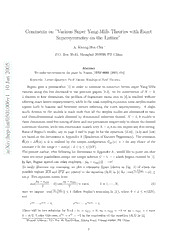
Comments on "Various Super Yang-Mills Theories with Exact Supersymmetry on the Lattice" PDF
Preview Comments on "Various Super Yang-Mills Theories with Exact Supersymmetry on the Lattice"
Comments on ”Various Super Yang-Mills Theories with Exact Supersymmetry on the Lattice” A. Kwang-Hua Chu ∗ P.O. Box 30-15, Shanghai 200030, PR China 5 0 Abstract 0 2 We make corrections on the paper by Sugino [JHEP 0501 (2005) 016]. n a Keywords: Lattice Quantum Field Theory, Topological Field Theories. J 0 Sugino gave a presentation [1] in order to continue to construct lattice super Yang-Mills 1 theories along the line discussed in the previous papers [2-3]. In his construction of N = 2, 1 4 theories in four dimensions, the problem of degenerate vacua seen in [2] is resolved without v 6 affecting exact lattice supersymmetry,whileintheweak couplingexpansionsomesurplusmodes 0 0 appear both in bosonic and fermionic sectors reflecting the exact supersymmetry. A slight 1 modi- fication to the models is made such that all the surplus modes are eliminated in two- 0 5 and three-dimensional models obtained by dimensional reduction thereof. N = 4, 8 models in 0 / threedimensions need fine-tuningof threeand one parameters respectively to obtain the desired t a l continuum theories, while two-dimensional models with N = 4, 8 donot requireany fine-tuning. - p Some of Sugino’s results, say, in page 3 and in page 10 for the equations (2.10), (3.5) and (3.6) e h are based on the derivations in AppendixA (Resolution of Vacuum Degeneracy). Theminimum : v Φ~(x) + ∆Φ~(x) = 0 is realized by the unique configuration U (x) = 1 for any choice of the µν i X constant r in the range r = cot(φ) : 0 < φ≤ π/(2N). r a The present author, after following his derivations in Appendix A., would like to point out that there are other possibilities except the unique solution U = V = 1 which Sugino claimed in [1]. In fact, Sugino missed one other condition : [u +v ]/2 = −π! k i(k) To easily illustrate our reasoning, we plot a schematic figure (shown as Fig. 1) of which the possible regions A′A and B′B are related to the equation (A.9) in [1] for |cos(uk+vi(k) −φ)| ≥ 2 cosφ. This equation comes from u +v u −v k i(k) k i(k) cos( −φ)cos( )= cosφ, k =1,···,N, (1) 2 2 once we impose |cos(uk−vi(k))| ≤ 1 (follow Sugino’s reasoning in [1]), where 0 < φ ≤ π/(2N), 2 and eiu1···eiuN =1, eivi(1) ···eivi(N) = 1. There will be two solutions for N=1 : u = v = π; u = v = −π or u = v = π once 1 i(1) 2 i(2) 2 i(2) φ= π/2. Under this case, eiu1 = eiπ = −1 in the expression of the equation (A.4) in [1]. ∗Present Address: P.O.Box 39, Tou-Di-Ban, XihongRoad, Urumqi830000, PR China. 1 2 References [1] F. Sugino, JHEP 0412, (2004) 060 [hep-lat/0410035]. [2] F. Sugino, A lattice formulation of super Yang-Mills theories with exact supersymmetry, JHEP 0401 (2004) 015 [hep-lat/0311021]. [3] F. Sugino, Super Yang-Mills theories on the two-dimensional lattice with exact supersym- metry, JHEP 0403 (2004) 067 [hep-lat/0401017]. 3 B A f f f f B' A' Fig. 1 Schematic plot for the possible region A′A and B′B for the equation (A.9) in [1] for |cos(uk+vi(k) −φ)| ≥ cosφ, 0 < φ≤ π/(2N), k = 1,···,N. 2
